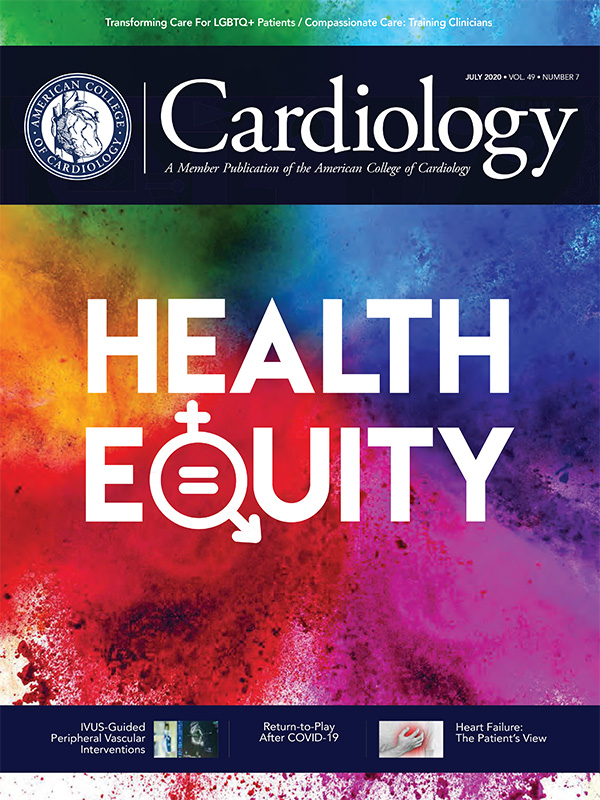Cover Story | Transforming Care for LGBTQ+ Patients

Cardiovascular disease does not discriminate. It affects everyone, regardless of race, ethnicity, sex and gender. Yet, a growing body of data continues to show significant disparities in care among specific populations as a result of factors ranging from bias to access to health insurance.
With roughly 10 million adults in the U.S. identifying as lesbian, gay, bisexual, transgender, queer and more, the LGBTQ+ community is one of the populations arguably among the most underserved when it comes to health care.
Surveys of the LGBTQ+ community over the years have identified informal barriers to care, including patients not seeking care because of bias, discrimination and discomfort, along with the inability to find culturally competent health care providers.
There are also more formal, structural barriers to care, such as a lack of health insurance.
Furthermore, LGBTQ+ patients have been essentially invisible until recent years and excluded from health research, including for cardiovascular disease, resulting in a lack of evidence to guide prevention and treatment.
What We Do Know

Not surprisingly, because of the lack of research and data, the ability to characterize the rates and types of cardiovascular disease in the LGBTQ+ community is limited. Much of the available data is based on self-reporting in studies and surveys.
However, what is clear is that the rate of modifiable risk factors for cardiovascular disease is higher in LGBTQ+ individuals. And the risk is further increased for those who are a racial or ethnic minority.
Among women who are lesbian, rates of overweight or obesity tend to be higher,1 raising the risk of hypertension, diabetes, heart disease and other health problems. A secondary analysis of National Health and Nutrition Examination Survey (2001-2012) data found that sexual minority women were 1.61-times more likely to be obese, and 1.56-times more likely to have a glycsolated hemoglobin consistent with prediabetes.2
There also tends to be higher rates of smoking (2-times higher), physical inactivity and stress, again increasing the risk for stroke and heart disease. Among men who identify as gay, there are higher rates of smoking (about 50% more than the general population) and stress, and abuse of alcohol and substances.
ACC takes PRIDE in its LGBTQ+ members and staff. Diversity of perspectives and experiences makes the profession stronger and is crucial to our effort to transform cardiovascular care and improve heart health.
Interested in sharing your story? Contact cardiologyeditor@acc.org.
An analysis using data from the Centers for Disease Control and Prevention's (CDC) Behavioral Risk Factor Surveillance System found a higher rate of a myocardial infarction (MI) after adjustment for age, diabetes, hypertension, hypercholesterolemia, chronic kidney disease, smoking and exercise.3
Transgender men had a greater than two-fold higher rate of MI compared with cisgender men and four-fold higher rate than cisgender women. Transgender women had a two-fold increased rate of MI compared with cisgender women, but did not have a significant increase compared with cisgender men.
There is a bit more data, although it remains sparse, on the effect of gender-affirming hormone therapy on cardiovascular disease risk. While it must be noted that all the data are retrospective, often relying on medical record review or self-reporting, the use of gender-affirming hormone therapy in transgender persons has shown to increase the risk of cardiovascular disease.
Cross-sex hormone therapy in transgender men has been associated with the potential of elevated blood pressure, insulin resistance and lipid derangements, and with an increased risk for thromboembolism and MI for transgender women.4,5
A large cohort study of 2,517 transwomen and 1,358 transmen who received cross-sex hormone therapy found that transwomen had a higher adjusted incidence of strokes and venous thrombolic events than reference women and men, and that both transwomen and transmen had a higher risk of MI than reference women.
The effects of hormones on lipid levels, the authors suggested, may be responsible for the higher rates of cardiovascular events.6
Looking Ahead

There are efforts underway led by the U.S. Department of Health and Human Services (HHS) to collect health data on LGBTQ+ populations to provide the information needed by researchers, health care providers, policy makers and advocates to identify and address health disparities.
This includes data collection on sexual orientation and health by the HHS, the CDC and the Health Resources and Services Administration. The National Institutes of Health in 2015 established the Office of Sexual and Gender Minority Research Office, whose work is being guided by a strategic plan to advance sexual and gender minority-related research and encourage cultural competency training opportunities, among other goals.
Healthy People 2020 set an objective to improve the health, safety and well-being of LGBTQ+ individuals, leading with data collection to understand the disparities to provide a foundation to work towards health equity.
Bottom line? The stigma, discomfort and lack of access means care is delayed or avoided, reducing or eliminating preventive care and the early detection and treatment of risk factors and health problems.
Compassionate Care: Training Clinicians

As a medical student, I received no formal education regarding LGBTQ health care. As a family medicine resident, I worry that tomorrow's physicians will not practice with the knowledge to provide culturally competent and appropriate medical care to these patient populations in hopes of reducing these health care disparities."9
A major issue, even today, is a lack of education and communication on LBGTQ+ health care issues in medical schools and residency programs. Indeed, there are no requirements that include formal training on these issues.
The 2017-2018 curriculum inventory report from the American Association of Medical Colleges found that while 76% of participating schools included some LGBTQ+ health themes, half reported three or fewer learning activities, such as a lecture or group discussion.9
An oft-cited study published in the Journal of the American Medical Association in 2011 found a median of five hours of LGBTQ+ content among the 150 U.S. and Canadian medical schools that completed the survey.10
Respondents rated much of the instruction as "poor." Most of the teaching was "interspersed" among the curriculum and just seven schools required that students attend such education.
A survey of 4,264 medical students a couple of years later found 67.3% rated their education in this area as "fair" or worse, with students reporting they felt least prepared in areas of transgender care. Yet even just two hours or less of focused lectures can improve student competency.11
Meanwhile, a survey of 1,010 medical, dental and nursing students found that 48% agreed their training had prepared them to care for LGBTQ+ patients and 45% agreed they knew where to look for information regarding LGBTQ+ health.12 Overall, 79% were interested in receiving more education about the topic.
"We approach the topic of diversity with a broad lens in our division and openly discuss race, gender identity and sexuality," says Katie Berlacher, MD, FACC, who directs the cardiology fellowship program at the University of Pittsburgh.
"We are thoughtful about the use of pronouns, as well as avoiding words like 'boyfriend/girlfriend/wife/husband,' and remind our fellows and faculty to use the word 'partner.'"
But, she adds, "At the fellowship level, we do not have a more formalized program and I am not aware of other fellowships in the nation that do."

"When thinking about diversity and inclusion, we need to think beyond curriculum and framework," Berlacher says. "Just as important are the policies and culture we create in our institutions, which are seemingly harder to cultivate."
Mark Rosenthal, MD, FACC, who directs the cardiology fellowship program at Atlantic Health System's Morristown Medical Center in northern New Jersey, agrees.
"There are no didactics on this subject at the fellowship level." He adds, "I teach this by example and my trainees learn by observation, like so much of what they learn in our program."
For instance, he uses the noun "partner" rather than "husband" when talking to a woman or "wife" when talking to a man. He also wears a rainbow pin on his doctor's coat, a piece of advice he received from his 28-year-old son, who is in the sixth year of an MD-PhD program in neuroscience, and is gay.
"It seems so simple," he says of the pin, "but this has opened many doors of communication in the exam room."
"If a patient asks about the pin, I tell them where the idea came from and that every day is pride day for my wife and me with Zachary," he says.
"And then I hear the patient's sigh of relief. More time than not they immediately come out to me or tell me about their own gay family member. We chat briefly about it and then the rest of the visit is relaxed, cardiology focused, but much more fun for both patient and doctor."
Barriers to Care

Access to health care for all in the U.S. continues to be a top priority. Overall, too many people lack the affordable health insurance they need to ensure regular health care. For members of the LGBTQ+ community, obtaining health insurance is even more challenging.
Many employee-sponsored health insurance programs do not recognize and insure partners or spouses of the opposite sex. For transgender individuals, not only is employee-sponsored health insurance often not an option, but the high rates of poverty limit the capacity to purchase any health insurance.
A snapshot of the barriers is provided from responses to the 2016 U.S. Transgender Survey:
- 33% did not see a doctor when needed because they could not afford it.
- 25% reported a problem with their insurance in the previous year, including denial of coverage for routine care because they were transgender.
- 55% of those who sought coverage for transition-related surgery were denied.
- 25% of those who sought coverage for hormones in the past year were denied.
While the Affordable Care Act (ACA) has brought some progress in health care coverage and access, this has not been a universal gain. Furthermore, in June, the Trump administration removed anti-discrimination protections for LGBTQ+ individuals in health care and health insurance, defining "sex" as biological sex. These rights have been protected since the ACA passed in 2010 prohibiting discrimination based on sex and were affirmed in 2016 to specifically include transgender patients.
Notably, the HHS' Office of Civil Rights stated in the final rule that it expects nearly 69,000 (50%) covered entities to rescind protections through changes in policies and procedures. These covered entities include hospitals, insurers, state Medicaid agencies, community health centers and physician practices.
Fear of the Doctor

The literature is rife with examples of LGBTQ+ patients experiencing significant discrimination in the medical system, such that many dread going (and often don't go) to the doctor or even the emergency room. Add in the fact that they are also less likely to have health insurance, it's understandable why they tend to have poorer health than gender-conforming individuals.
The 2015 U.S. Transgender Survey,7 which included 27,715 transgender participants from all 50 states, the District of Columbia, several U.S. territories and overseas military bases, found high levels of mistreatment when they sought health care:
- 33% had at least one negative experience related to being transgender when they sought care, including verbal harassment or refusal of care. The rates were higher for people of color or with disabilities.
- 23% did not seek health care in the previous year because of fear of mistreatment.
Notably, 50% of respondents in the 2011 National Transgender Discrimination Survey with 6,450 transgender participants stated they needed to teach the medical provider about their health care needs.8 Only 28% said they had disclosed their status to all their health care providers, 18% had shared with most, 33% with a few, and 21% had not shared their status with any providers.
One participant shared: "Denial of health care by doctors is the most pressing problem for me. Finding doctors that will treat, will prescribe, and will even look at you like a human being rather than a thing has been problematic. Have been denied care by doctors and major hospitals so much that I now use only urgent care physician assistants, and I never reveal my gender history."
Most persons who identify as LGBTQ+ do not have a consistent primary care provider – limiting their ability to have regular, safe and preventive care.
Case Study: The Mayo Clinic's Transgender and Intersex Specialty Clinic

To create a safe place for transgender patients, the Mayo Clinic in Rochester, MN., created a gender affirming, multidisciplinary clinic for patients with gender identity, gender expression or gender behavior different from the person's physical attributes.
Staff are specially trained in gender-correct pronouns, and subspecialists, including plastic surgery, endocrinology, psychiatry and psychology, laboratory medicine, and general internal medicine, come to the clinic so patients don't have to traverse numerous specialty offices. What started as a half-day clinic, is now fully booked for most of the week.
The Mayo Clinic offers these tips to become a transgender-friendly and competent provider:
- Don't be afraid to ask about your patient's gender nonconformity.
- Ask patients their preferred names and pronouns and use them during the encounter. If you make a mistake, apologize and continue.
- Understand the preferred name and pronoun will often differ from what is in the medical record as many transgender people have not changed their names and genders legally. Ask the patient if you can use this preferred name and pronoun in the medical record. Remember that many patients may have access to their medical records, so your sensitivity should be reflected in the notes.
- If possible, intake forms should include an option to disclose transgender status.
- Sensitivity training should be required for all staff members who interact with the patient.
- Include a unisex public restroom option.
- Provide local transgender resources such as support groups to help guide the patient if needed.
- Include transgender health topics as part of your medical school and training programs.
- Provide faculty development in transgender health.
- Identify qualified providers in your area that you can contact about transgender-related questions.
Cultural Competency: Resources
More and more health care facilities are working to be inclusive of the LGBTQ+ community. The Health Equity Index (HEI), created by the Human Rights Campaign Foundation and the GLMA, had a record 680 institutions across the U.S. participate in their 2019 survey.
The HEI listings are a quality indicator and help LGBTQ+ patients find facilities that provide equitable and inclusive care.
The HEI also provides best practices, free online on-demand staff training (including CME credits) and more. To learn more, visit HRC.org/HEI.
References
- Struble CB, Lindley LL, Montgomery K, et al. Overweight and obesity in lesbian and bisexual women. J Am College Health 2010;59:51-6]
- Caceres BA, Brody AA, Halkitis PN, et al. Cardiovascular disease risk in sexual minority women (18-59 years old): Findings from the National Health and Nutrition Examination Survey (2001-2012). Womens Health Issues 2018;28:333-41.
- Alzaharani T, Nguyen T, Ryan A, et al. Cardiovascular disease risk factors and myocardial infarction in the transgender population. Circ Cardiovasc Qual Outcomes 2019;12:e005597.
- Streed CG Jr., Harfouch O, Marvel F, et a. Cardiovascular Disease Among Transgender Adults Receiving Hormone Therapy: A Narrative Review. Ann Intern Med 2017;167:256-67.
- Connelly PJ, Freel EM, Perry C, et al. Gender-affirming hormone therapy, vascular health and cardiovascular disease in transgender adults. Hypertension 2019;74:1266-74.
- Nota NM, Wiepjes CM, de Blok CJM, et al. Circulation 2019;139:1461-62.
- James SE, Herman JL, Rankin S, et al. Executive Summary of the Report of the 2015 U.S. Transgender Survey. Washington, DC: National Center for Transgender Equality. 2016. Available here. Accessed June 26, 2020.
- Grant JM, Mottet LA, Tanis J. Injustice at Every Turn: A Report of the National Transgender Discrimination Survey. National Center for Transgender Equality. 2011. Available here. Accessed June 26, 2020.
- Johnson N. LGBTQ health education: where are we now? Acad Med 2017;92:432.
- Obedin-Maliver J, Goldsmith ES, Stewart L, et al. Lesbian, gay, bisexual, and transgender-related content in undergraduate medical education. JAMA 2011;306:971-7.
- White W, Brenman S, Paradis E, et al. Lesbian, gay, bisexual, and transgender patient care: Medical students' preparedness and comfort. Teach Learn Med 2015;27:254-63.
- Dowshen N, Nguyen GT, Gilbert K, et al. Improving transgender health education for future doctors. Am J Public Health 2014;104:e5-6.
- Maragh-Bass AC, Torain M, Adler R, et al. Is it okay to ask: transgender patient perspectives on sexual orientation and gender identity collection in healthcare. Acad Emerg Med 2017;24:655-67.
Clinical Topics: Cardiovascular Care Team, Diabetes and Cardiometabolic Disease, Dyslipidemia, Homozygous Familial Hypercholesterolemia
Keywords: ACC Publications, Cardiology Magazine, Transgender Persons, Health Services for Transgender Persons, Ethnic Groups, Sedentary Behavior, Behavioral Risk Factor Surveillance System, Prediabetic State, Risk Factors, Cardiovascular Diseases, Hypercholesterolemia, Minority Groups, Homosexuality, Female, Homosexuality, Homosexuality, Male, Bisexuality
< Back to Listings

